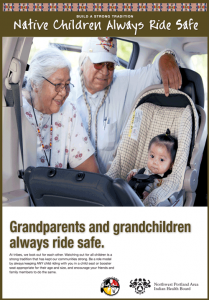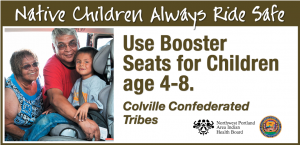Native CARS Examples
Here are four examples of campaign materials we used.
Example #1
Issue: Non-parent drivers were more likely to have children improperly restrained.
Target audience: Elders
Action audience should take: Elders should keep children under age 13 in an appropriate child safety seat in the back seat of the vehicle.
Special considerations:
- Models should look like an elder and dress like an elder.
- Text should be large and readable.
- Language should address specific issues for elders.
- Message could consider values that elders hold dear—future generations, traditions, or beadwork.
Media samples:
Poster- Elders and infant from the Shoshone-Bannock Tribes with infant rear facing (click for full-size pdf):
Radio PSA – Elder from Colville speaking:
Television PSA – Elder from Nez Perce speaking:
Billboard – Elders/child in child safety seat (click for full-size pdf):
Example #2
Issue: Children were transitioning from booster seats to adult seats too early for their age and size.
Target audience: Booster-seat-aged kids (4–8 years old and up to 4’9″) and drivers of kids in booster seats
Action audience should take: 1) Children and parents should continue using a booster seat until the child is 4’9″. 2) They should also know and use the five step test to graduate from a booster seat.
Special considerations:
- Images need to show that booster seats are acceptable for heavier children or “tough guys” under 4’9″.
- Visuals should be attractive to 4–8 year olds.
- Visuals could be superhero-themed, sports-themed, or princesses-themed.
- Children should star in the radio and video PSAs.
Media samples:
- Poster: Hulk Hands and Booster Seat
- Billboard: Booster Seat Billboard from Colville
- Table Top display: Booster Seat Use and 5-Step Test
Example #3
Issue: People were buckling their seat belt when driving off the reservation, but unbuckling it when they drove onto the reservation. Children riding off the reservation were also more likely to be properly restrained than children riding on the reservation.
Target audience: People driving on and off reservations
Action audience should take: 1) Understand that children are always safer in a proper child safety seat—whether on or off the reservation. 2) Adults get in the habit of using seat belts, because children watch and will copy their attitudes and behavior.
Media samples:
- Billboard: Spokane [link]
- Video PSA: Spokane
Example #4
Issue: Families didn’t see law enforcement as part of the solution to having children properly restrained in car seats.
Target audience: All drivers driving on and off the reservation
Action audience should take: 1) Begin to see local law enforcement as caring professionals who want to keep kids safe. 2) Understand you may be fined for not properly restraining your child.
Special considerations:
- Images should show families and law enforcement coming together to help protect children.
Media samples:
- Poster: [link] Shoshone Bannock, Nez Perce
More Resources
For more media campaign examples, please visit the Resources section of this module. The items in that section include media that are print-ready or customizable.
2. Create Your Own Media
Video or Radio Public Service Announcements:
It will be easiest to hire a contractor to make the video and radio PSAs. For example, some local TV stations or public radio stations may have staff that can help. But if you can’t, here are some tasks you can expect when creating video and radio PSAs.
- Discuss and decide on the issue, target audience, and action the audience should take.
- Discuss and decide on a creative concept that you want to execute.
- Write a rough draft of the script. You may want your coalition to review and revise your draft.
- Draw storyboards. Roughly sketch the sequence of the script, illustrating major changes in action.
- Recruit cast members and identify any needed props.
- Scout out locations for filming. Then determine if any equipment needs are required for that location.
- Prepare a shooting script for the shooting crew. This includes technical notes, sketches, and directions as needed.
- Make a schedule. Send emails and make phone calls to remind cast and crew to be available for the shoot or recording time. Be flexible and have backup options in case of cancellations.
- Notify cast members of the time they should be on location, any special instructions before they get to the location, and what they can expect on the day of the shoot or the recordings.
- Provide support on the day of the shoot to the videographer and crew as needed.
- Schedule any TV runs and send video copies to the TV stations.
- Plan, advertise, and host viewings of the video PSA to friends, family, and the community.
Posters, Billboards, Flyers, or Table-Top Displays
- Discuss and decide on the issue, target audience, and action the audience should take.
- Determine the main message you want to communicate.
- Discuss and decide on a creative concept that you want to execute.
- Draw rough draft stick figure drawing of what you imagine the media piece will look like.
- Determine whether you will be creating the media by yourself of if you’ll need to contract with a vendor.
- For example, if you’re not a skilled photographer, and your intention is to have professional posters printed, you can contact a professional photographer to take photos that may capture your concept best.
- Or if you’re not comfortable with graphic artist software, hire a graphic artist to construct your concept from your stick drawing and provided text. Skilled graphic artists may also have ideas in terms of layout, font style, and overall design that you had not considered that will improve the quality of your poster.
- Draft your text. Make sure you keep it brief, clear, and to the point. Provide contact information, if appropriate.
- Determine whether to use photos or illustrations.
- If photos:
- Recruit models and identify any needed props.
- Scout out locations for photo shoot. Then determine if any equipment needs are required for that location.
- If photos:
- Prepare any technical notes, sketches, and directions as needed for photographer.
- Make a schedule. Send emails and make phone calls to remind models and crew to be available for the shoot. Be flexible and have backup options in case of cancellations.
- Notify models of the time they should be on location, any special instructions before they get to the location, and what they can expect on the day of the shoot.
- Be prepared to have a dedicated person to provide support on the day of the shoot as needed.
- If illustrations:
- Have a graphic artist create rough sketches of the illustrations with text.
- Share these sketches with a formal focus group of community members or an informal focus group of trusted advisors and people from the target audience.
- Review the media with a focus group or those from the target group.
- Finalize the design and layout.
[image] (Have the image in a box with the description below placed below it)
Here is what our posters looked like, starting with stick drawings and evolving to the final product.
- Scout out locations for poster or billboard
- Finalize desired placement locations
- Determine evaluation criteria.
- If creating a billboard:
- Scout out locations for a poster or billboard.
- Determine whether billboard will be with a local advertising company that will rent you time limited space on an existing billboard or if you will be constructing a permanent and reusable billboard in your community.
- If considering a commericial billboard, most either have a logo visibly placed on their billboards are easily found by searching on the internet with search words such as “billboard rental in <name of state>”. Billboard companies often offer a number of levels of support from as little as just taking your predesgined electronic image and placing it onto their billboard to working with you on determining your objective, defining your target, audience, determining how to best reach your target audience, determining which type of billboard may be most appropriate and designing your billboard for you, and helping you evaluate its reach.
- If considering constructing a permanent resusable structure for your billboard image you likely will need to work with your planning or facilities departments to determine where your billboard can be placed and how over time it will be maintained. You may consider sharing this structure with another program(s) to share the expense and if you decide to do so you will need to document your agreement upfront as to how billboard space will be reserved and shared amongst programs. If you or your organization does not have the skills to build and erect the billboard structure you may need to contract someone to build the structure.
- Whether for you contractor or for you, here is specific information on how to construct a community billboard [link to document]
Here is what our posters looked like, starting with stick drawings and evolving to the final product.
[image]

